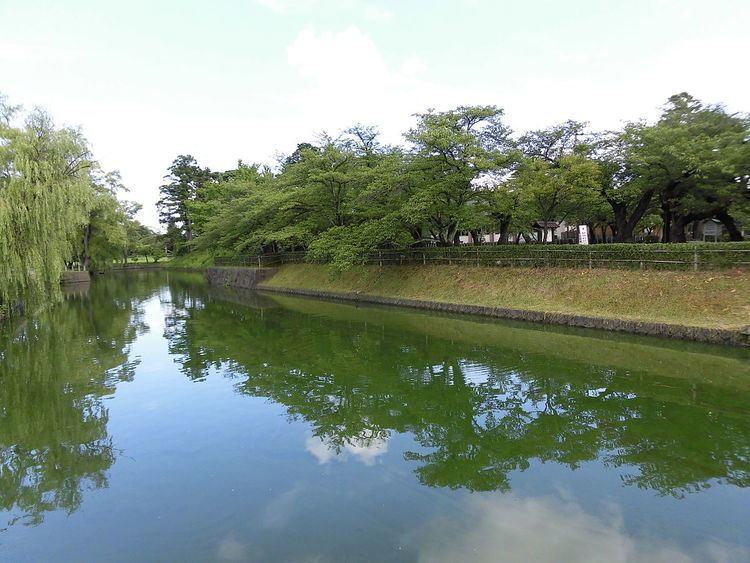 | ||
Shōnai Domain (庄内藩, Shōnai-han) was a feudal domain in Edo period Japan, located in Dewa Province (modern-day Yamagata Prefecture), Japan. It was centered on Tsuruoka Castle in what is now the city of Tsuruoka, Yamagata and was thus also known as the Tsuruoka Domain (鶴岡藩, Tsuruoka han). It was governed for the whole of its history by the Sakai clan, which resulted in an unusually stable and prosperous domain. During their rule over Shōnai, the Sakai clan was ranked as a Province-holding daimyō (国持ち大名, kunimochi daimyō) family, and as such, had the privilege of shogunal audiences in the Great Hall (Ohiroma) of Edo Castle. In the Boshin War of 1868–69, the domain joined the Ōuetsu Reppan Dōmei, the alliance of northern domains supporting the Tokugawa shogunate, but then later defected to the imperial side. As with all other domains, it was disbanded in 1871.
Contents
History
The Sakai rose to prominence with Sakai Tadatsugu, who was one of Tokugawa Ieyasu's Shitennō, or four leading generals and the daimyō of Matsushiro Domain in Shinano Province. After the death of Mogami Yoshiaki many internal struggles for control of the Mogami clan, the former rulers of Dewa Province, arouse and caused their vast domain to be divided into several parts. Sakai Tadatsugu was awarded the coastal region consisting of Tagawa, Akumi and Murayama districts, which increased his revenues from 38,000 koku to 138,000 koku, and then to 150,000 koku. However, the lands of the Shōnai region were fertile and well-watered, and eminently suited for growing rice, which gave the Sakai clan actual revenues of more than 200,000 koku. This revenue was further supplemented by the developed of Sakata port for the coastal kitamaebune trade, which gave the clan an actual income of closer to 300,000 koku.
In 1805, the domain academy, the Chidōkan was established by the 7th daimyō, Sakai Tadaari. The domain faced a severe crisis during the time of the 9th daimyō, Sakai Tadakata, when it came to the attention of Shogun Tokugawa Ienari that the domain's revenues had been understated by some 200,000 koku for many decades. Ienari decided to relocate the Sakai clan to Nagaoka Domain (74,000 koku) and to move the Makino clan from Nagaoka to Kawagoe Domain (150,000 koku). Matsudaira Narisasa of in Kawagoe (who happened to be Ienari's son) would then be given Shōnai. The proposal sparked tremendous outrage in Shōnai domain, and a large number of commoners, merchants, samurai and officials descended upon Edo in 1840 to file protests and petitions in what came to be known as the Tenpo Gimin Jiken (天保義民事件).The move was cancelled by the timely deaths of both Ienari and his son Matsudaira Narisada within weeks of each other in 1841 and Shōnai was "punished" by being assigned various public works projects.
During the Bakumatsu period, Shōnai was assigned the task of building fortifications and providing increased security for Edo from the incursions of foreign ships, and had its official income increased to 167,000 koku in 1864. In January 1868, samurai from Shōnai domain joined with Kaminoyama Domain in an attack on the Satsuma Domain residence in Edo – which marks the start of the Boshin War. Shōnai was initially a strong supporter of the Ōuetsu Reppan Dōmei, an alliance of northern domains against the forces of the western-based Satsuma-Chōshu Alliance attempting to overthrow the Tokugawa shogunate. However, Shōnai (along with the other military leader in the region, Aizu Domain) did not sign initially sign the treaty forming the Alliance and only became an official member in early 1868. Shōnai was regarded with caution by the Satchō Alliance, as it had deep financial resources, and had rearmed with modern weapons supplied by the Schnell brothers. However, after the defection of Kubota Domain to the imperial side, and the defeat of the Northern Alliance at the Battle of Hokuetsu and the Battle of Aizu, Shōnai Domain surrendered without a fight in December. Sakai Tadazumi turned the domain over to his son, Sakai Tadamichi and the domain was reduced to 120,000 koku. However, in June 1869, the Sakai were ordered to relocate to Iwakitaira Domain. This move was strongly protested by the people of the domain, who raised 300,000 ryō as payment to the Meiji government, and obtained the support of Saigō Takamori to have the order rescinded. In 1870, the domain name was changed to Oizumi Domain (大泉藩, Oizumi-han). The domain was abolished together with all of the domains in the abolition of the han system in 1871, becoming Sakata Prefecture and Tsuruoka Prefecture, which then merged into Yamagata Prefecture. The Sakai clan was ennobled in 1885, becoming hakushaku (counts) in the kazoku peerage.
List of daimyō
Bakumatsu period holdings
Dewa-Matsuyama Domain
Dewa Matsuyama Domain (出羽松山藩, Dewa Matsuyama han) was founded in 1647 for Sakai Tadatsune, the third son of Sakai Tadakatsu, who was assigned 20,000 koku of new rice lands in Akumi District. The third daimyō, Sakai Tadayoshi served as wakadoshiyori, and was awarded an additional 5000 koku in Kōzuke Province. He also built the Dewa-Matsuyama Castle, from which his successors continued to rule until the Meiji Restoration. During the Boshin War, the domain sided with the Ōuetsu Reppan Dōmei, for which it was punished by the Meiji government with the loss of 2500 koku. It was renamed Matsumine Domain (松嶺藩, Matsumine han) in 1869, and was abolished with all the other domains in 1871. The final daimyō, Sakai Tadamasa subsequently received the kazoku peerage title of shishaku (viscount).
Bakumatsu-period holdings
Ōyama Domain
Ōyama Domain (大山藩, Ōyama-han) was founded in 1647 for Sakai Tadatoki, the seventh son of Sakai Tadakatsu, who was assigned 10,000 koku of new rice lands in Tagawa District. It reverted to the parent domain on his death in 1668 without an heir.
